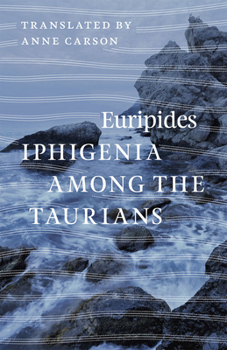Iphigenia among the Taurians
Select Format
Select Condition 
Book Overview
I am Iphigenia, daughter of the daughter of Tyndareus
My father killed me Few contemporary poets elicit such powerful responses from readers and critics as Anne Carson. The New York Times Book Review calls her work "personal, necessary, and important," while Publishers Weekly says she is "nothing less than brilliant." Her poetry-enigmatic yet approachable, deeply personal yet universal in scope, wildly mutable...
Format:Paperback
Language:English
ISBN:022620362X
ISBN13:9780226203621
Release Date:September 2014
Publisher:University of Chicago Press
Length:72 Pages
Weight:0.30 lbs.
Dimensions:0.3" x 5.4" x 8.3"
Related Subjects
Drama History Literary Literary Criticism & Collections Literature Literature & FictionCustomer Reviews
1 rating
Euripides solves the mystery of Iphigenia after Aulis
Published by Thriftbooks.com User , 22 years ago
At the end of "Iphigenia at Aulius," when the virgin daughter of Agamemnon is about to sacrificed offstage to appease the goddess Artemis, as the fatal blow is struck the young girl disappears and a stage appears in its place. Thus, at the last minute, Euripides refrains from suggesting a goddess demanded a human sacrifice. But what happened to the young girl? The dramatist provides his answer in "Iphigenia in Tauris" Artemis saved Iphigenia and brought her to the temple of the goddess in Tauris (which is in Thrace, although others take this to mean the Crimea). Meanwhile, her brother Orestes, still trying to appease the Furies for his crime of matricide, is ordered by the god Apollo to bring the statue of Artemis from Tauris to Athens. However, the Taurians have the quaint habit of sacrificing strangers to the goddess (so much for the goddess disdaining human sacrifice). Once again, Euripides is showing his disdain for Apollo; at first consideration you might think Apollo is setting up the reconciliation of brother and sister, but since it is up to the goddess Athena to help the pair, and Orestes's friend Pylades, to escape, the clearly implication is that Apollo wants Orestes dead. "Iphigenia in Taurus" ("Iphigeneia en Taurois," which is also translated as "Iphigenia among the Taurians") is really more of a tragicomedy than a traditional Greek tragedy. Basically it consists of a key scene of recognition ("anagnorisis") and a clever escape by the main characters. The recognition scene between Orestes and Iphigenia is well done, and so atypical in that there is joy in the "anagnorisis" rather than pain or death (cf. "Oedipus the King"). "Iphigenia in Tauris" takes place after the Orestia trilogy by Aeschylus (Athena refers to the events of the final play), and one of the more interesting elements of this play is the idea that Orestes had been hallucinating when he was seeing the Furies pursuing him. This is a rather rational explanation for his behavior following the murder of Clytemnestra and Aegithus. I was rather surprised to discover that Euripides wrote "Iphigenia in Tauris" in 413 BC, which was years before "Iphigenia at Aulis" was first performed in 406. I had naturally assumed that Euripides was following the character's chronology, but apparently this is not the case. My preference has always been for the latter play, but this is based on my interest in how Euripides foreshadows the conflict between Agamemnon and Achilles that serves as the opening conflict of Homer's epic poem, "The Iliad." This also speaks to the fact that to successfully teach and/or really appreciate this play, you simply have to understand the entire background of the characters, both in terms of "Iphigenia at Aulis" and "The Orestia." Certainly this can be done in the classroom through summaries of these plays, but it most assuredly has to be done.





